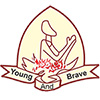Short History of St. Kizito of Uganda
Saint Kizito (1872-June 3, 1886) was one of the Martyrs of Uganda. The youngest martyr slain by the King Mwanga II of Uganda, he was burned alive in 1886. He was canonized on 18 October 1964 by Pope Paul VI at Rome.
Catholic Christianity began to take root in Uganda after Cardinal Lavigerie's White Fathers established missions in central Africa in 1879. Progress was made under the rule of the not unfriendly local chieftain named Mtesa; however, his successor, Mwanga detested the faith that would accuse him of debauchery.
King Mwanga of Uganda took as chief steward a young Christian named Joseph Msaka Balikuddembe. Joseph detested the king's debauched ways, especially his attempts to corrupt other young men of Uganda, whom the steward tried to protect. Mwanga distrusted visitors, fearing they might report his evil ways to the British government, which had given him his power
In October 1885, Mwanga ordered his followers to kill an Anglican missionary, Bishop James Hannington. The Catholic steward Joseph protested at the murder of a fellow Christian. The following month, Mwanga had him beheaded. "A Christian who gives his life for God is not afraid to die," Joseph proclaimed. "Mwanga has condemned me without cause; but tell him I forgive him from my heart." To the king's astonishment, the Christians were not cowed by his sudden outrage
Six months later Mwanga's savagery was even worse. He discovered that a 14-year-old page, Mwafu, had been receiving instruction in the Catholic faith. He called for Denis Sebuggwago, who had been teaching the page, and killed him by thrusting a butcher's cleaver or spear through his throat. That night Charles Lwanga, the new master of the pages, baptized five of them including Kizito, who he had repeatedly rescued from Mwanga's pederasty.
The next day the baptisms were discovered. Enraged, Mwanga assembled all the pages and ordered the Christians to separate themselves from the others. Fifteen, all under the age of 25, did so at once and were later joined by two others who were already under arrest and by two soldiers. They were asked if they wished to remain Christian and each replied, "Until death." The king then ordered every Protestant and Catholic living in the royal enclosure to be put to death
Thirty-two Catholics and Protestants were led 37 miles away to a place called Namugongo to be burned to death in a literal holocaust. Three were killed on the way. One of these, a district judge named Matthias Kalemba, declared, "God will rescue me. But you will not see how he does it, because he will take my soul and leave you only my body.' He was cut into pieces and left to die slowly by the roadside
The rest of the martyrs were taken to Namugongo. They were imprisoned there for seven days while a huge pyre was prepared. At the appointed time on Ascension Day, they were forced to lie down on reed mats. Wrapped up in the mats and tightly bound, they were laid side by side
Fuel was poured on them, and they were set afire. As their executioners sang barbarously, the martyrs died confidently praying to their Saviour. Kizito's final words were, "Goodbye, friends, we are on our way." He became the youngest Roman Catholic saint to be martyred, at the tender age of 13. Along with Lwanga and his companions, Kizito was beatified in 1920 by Pope Benedict XV and canonized on October 18, 1964, by Pope Paul VI. He is the patron saint of children and primary schools; his joint feast day with Lwanga and 20 others is June 3
The persecution spread. A leader among the confessors was Matthias Murumba, who was killed with revolting cruelty. During the reign of Mwanga about 100 Christians of various denominations were martyred
